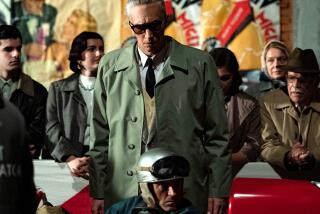1991 LAMBORGHINI DIABLO : A Speedy Demon
- Share via
Supercars take their name from being superordinate to adult fantasies, most lines of credit and all levels of personal cowardice.
Yet there remains no shortage of buyer-harebrains willing to bet limb and longevity on the rush of driving a 200-m.p.h., street-legal race car.
Despite war and a noticeable shriveling of auto sales, the fire-breathing, 500-horsepower Ferrari F40 still sells in California for $200,000 above its $400,000 sticker price.
Don’t even bother pricing the Porsche 959, Germany’s twin-turbocharged supercar. Porsche chose not to certify its 205-m.p.h. screamer for the American market. No matter. European buyers were in a bidding war before the first car was built, and the limited line is sold out.
In England, Jaguar and BRM have supercars in the works. Other cars are under design in Germany, Italy, the United States and even Czechoslovakia. Nissan is testing a prototype of a 200-m.p.h. street car.
Now, shake hands with the devil.
It’s the Lamborghini Diablo, an Italian cruise missile that is the 202-m.p.h. replacement for Lamborghini’s Countach, suddenly an outdated slowpoke of 180 m.p.h.
Designed and built by Lamborghini, modified a little and given a less Spartan interior by new parent Chrysler Corp., the Diablo is expected to go on sale in California next month.
“The first shipments . . . will leave Italy this first week in February,” says Al Imber, president of Lamborghini USA Inc., of Jacksonville, Fla. “Listening to our dealers, interest in the car is phenomenal.
“From what they want in orders, and what I know we are going to get, which is eight or 12 cars a month for the entire country, we’re probably sold out for the next 18 months to two years.”
The Diablo’s suggested retail price is $223,000, which does not include the new luxury tax of approximately $20,000. That also is just about what the first year’s insurance premium should be. Do not expect Allstate to return your calls.
Fitted luggage comes with the car because the trunk is small and misshapen with barely enough room for one tote, two teddies and a fanny pack. A cute little dash clock costs extra because it is a Breguet. At $12,000 it clearly is the final option.
Do not ask about Lamborghini’s cash-rebate program.
Rick Cole, the partner preceding the hyphen of Cole-Yacoobian Auto Collection, says a new Diablo could sell for up to $500,000 as “the first toy on the block.”
He recently accepted a used, low-mileage European Diablo on consignment and represents its owner, an English attorney.
“I have actually had two or three offers,” said Cole, who also is president of Rick Cole Auctions of North Hollywood. “We had originally hoped to get about $450,000 for it and I think we’ll get close.”
For the price of a Brentwood condo, the new owner will get a car that accelerates from dead stop to 60 m.p.h. in less time than it takes you to read this sentence. Or just over four seconds.
The Diablo can exceed 65 m.p.h. in first gear. Thirty seconds after a fast start, the car will be more than a mile from where it started and closing on terminal velocity. To blink for half a second at 202-m.p.h. means you just missed seeing the last 50 yards.
That, to follow the old refrain, is what the car will do.
But what the car is really has very little to do with speed. Pace is a false criterion established by those who presume speed represents superiority.
The truth of a supercar such as the Diablo starts at the gearshift. It is still guided by a steel cutout. Ettore Bugatti and Tazio Nuvolari had such cattle guards in their race cars of the ‘30s.
The Diablo is not turbocharged because manufacturers of thoroughbred Italian cars march to a simple drummer. They prefer the beat of the V-12 that first appeared on race circuits in 1919. They continue to argue the point that expanding the whole engine is as valid as refining its parts.
There are no anti-lock brakes on the Diablo. Nor a multilink suspension system. Nor much computer assistance beyond an engine management setup suggested by Chrysler.
An air bag was added as a concession to American sissies. Brake and clutch pedals are too tiny for feet in Size 11 1/2 Reeboks and are set with leaden pressures that would tire a place-kicker. There is no power steering.
The Diablo is a gasaholic. At 9-miles-per-gallon around town, its thirst is the world’s worst. By unhealthy comparison, it guzzles 10% more unleaded premium that a Rolls-Royce Silver Spirit.
Said a technical spokesman for the factory: “We use only the technology on this car that we need, no more.” Translation: Japan builds toys, Italy crafts tools.
It is a very simple mentality that is part devotion to quintessence and the primordial. And equal part stubbornness to change.
Some persons still write with fountain pens. Others light their Camels with Zippo lighters. Real men wear A-2 leather jackets by Avirex.
And only real drivers, continues the theory, are capable of handling Italian sports cars where creature discomfort is considered necessary to the experience. No pain, no speed. Huge is powerful. Noise is performance. Without nimbleness and reflexive precision to overcome heavy handling and unpredictable behavior, there can be no moment of truth.
Bullfighters understand.
And Diablo was indeed taken from the name of a championship bull.
Our test car, currently the only privately owned Diablo in the United States, came courtesy of Cole-Yacoobian and their client the solicitor. Also their one-bedroom Kenworth transporter, which carried the car to Willow Springs International Raceway near Rosamond for an afternoon of medium running.
As with all Lamborghinis since the very first 400GT of 1966, the Diablo is brooding, evocative, quite beautiful and definitely the automotive fancier’s next poster child.
Gone are the edges, angles and appendages that gave the 20-year-old Countach the stance of a mantis sniffing for sirloin. The Diablo look is 1999 with rounded corners, softened edges and a styling lines that, like smoke streams in a wind tunnel, progress from front to back and around the car.
There’s a continuity to the Diablo that was lacking on the Countach. Pick a viewing line--dorsal, ventral or mid-car. It starts low at the front dam, rises smoothly above the forward wheel arches and follows parallel curves of the roof and window sill. Then it continues to the rear of the car, squeezing in on itself to a back end that is a sculpture in steel, aluminum and Kevlar.
Everything at the back of the Diablo is a perfect balance of dimension, shape, number and positioning.
Four round rear lights are outboard of four round tailpipes beneath a rounded lower air dam that is in visual symmetry to the upper valance. And the long, louvered deck over the mid-mounted V12 has been dropped a little lower in its channel to increase visibility through the rear window.
A Lamborghini trademark, the five-hole, egg-poacher cast alloy wheels are carried over from the Countach. The doors, another hallmark, still open vertically. In short, this car may be Modenese but its design--by Marcello Gandini who also drew the Miura and Countach--is pure Florentine.
Mechanically, the Diablo is vastly improved. Displacement is up to 5.7 liters from 5.2 liters in the Countach. The Countach was 455 horsepower. The Diablo is 485 horsepower.
Would that all these good looks, all this mechanical promise, held up on the track.
Yes, the Diablo is wickedly fast and too quick for Willow Springs, where fifth gear was used for just a few blissful seconds on the pit straight. The car does indeed bellow, corner flat and pull like a locomotive coming out of the turns.
But it’s a crude supercar; long on muscle, short on finesse.
In a finger-snap, it will bite the hand that feeds it a smidge too much power. Oversteer is horrendous and the margin of error a whisker. About the only warning that the car is about to swap ends is when it is well into the happening.
At this point in the Diablo driving experience, a thought occurs: Had Italian supercars been around in 1349, they would have been banned by Pope Clement VI along with other forms of self-flagellation.
It is a heavy, almost clumsy vehicle with slow, unassisted steering. And almost two tons of car shifting in unexpected directions at speed is a guaranteed source of recurring night sweats.
Changing gears through that Nuvolari steel gate is too often a time for tugging and fumbling and, horrors, sometimes a quick glance down to make sure you’re not about to miss fourth and overcook that expensive gearbox in second.
There is not enough room for two well-sized loafers in the tunnel leading to the action pedals. The left-front wheel well--a traditional intrusion of all cab-forward designs--is the culprit here. So is the forward trunk that filches more available space from the right side of the tunnel.
There is absolutely no sense of security in seat belts--bearing in mind the insistent hurry of this car--that look like they came off a Honda Accord. Tall persons risk a sub-dural hematoma because of a beautifully curved door that arcs wonderfully into the left side of the driver’s skull.
Undeniably, this is a user-unfriendly car that will scare the diapers off all boy racers. Last year it did a fairly decent job on the reputations of two magazine writers.
One journalist wrote off the side of a Diablo on a pit wall at an Italian track. The other performed drastic surgery on the front end of a second car. And both writers were experienced test drivers.
This is not a car for anyone with hot blood, a short fuse and a reluctance to spend several thousand dollars and at week in Phoenix at the Bob Bondurant School of High Performance Driving.
It is a serious car for thoroughly experienced drivers who like to travel at 170-m.p.h. on the empty, arrow-straight motorways of Europe.
But who in the United States will buy a Diablo?
Definitely those who collect exotic cars for the same reason lesser mortals collect pocket watches: To polish, catalogue, admire and use cautiously just once in a while.
Diablos will go to investors who know today’s used Lamborghinis are all collectibles, worth ransoms more than their prices when new.
And they will be bought by brokers like Jim Glynn of Hermosa Beach and Hilton Head Island. He heads the Glynn Collection and has ordered several Diablos for resale.
He sees it as “the ultimate purist car or the ultimate art repro car . . . one of the few supercars that combines a number of elements into moving art.”
Glynn also recognizes that man is a creature of primal traditions. Tribesmen have worn the shrunken heads of their victims for protection from death. Mountain men have eaten bear livers to inherit the animal’s strength and courage.
But will a modern high roller buy a Diablo with the subconscious belief it will give him the touch of Nuvolari?
Says Glenn: “I think man still has totems he identifies with.”






